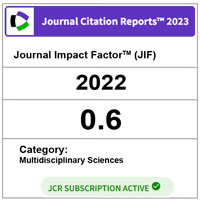Effective school cooperative-mart queuing system
DOI:
https://doi.org/10.11113/mjfas.v13n4-1.859Keywords:
queuing theory, queuing system, queue system performance parameterAbstract
Queuing Theory is a branch of knowledge in operation research that concerning the analysis of queues when a customer arrives at a service centre and shall queue in a line to get some service. The theory pays attention to how organizations can serve a large number of customers who demand a quality services and a queue of customers waiting to be served. Eventually, the store owners have to attend to large numbers of customers at a time have attempted to measure and manage queues to reduce the customer procession time. Besides, to increase sales and profit, productivity and operation efficiency, satisfaction levels and customer loyalty in using the service provided. In line to the situation, this study is to determine the effectiveness of the waiting line using Queuing Theory at cooperative-mart. Until today, no research conducted about school cooperatives-mart to observe and solve the massive inflow of customers at lines at a given time especially during lunch hour. The purposes of this study are to determine the customer congestion at the payment counter and to propose the effective queuing system at Cooperative-mart. Waiting and services times of customers at cooperative-mart is studied in three times period that to be considered as peak hours in two types of counter which are for male and female. Data collection was observed by using queuing theory and the M/M/1/∞/∞ queuing model has been implemented. The results show that for optimum service level, the counter must be changed from one to two counters each side. The summary and finding of the study shall be used as guideline for the management of cooperative-mart in deciding improvement of its operation.
References
Abdul Mukhti Husein. (1997). Pengalaman koperasi sekolah terbaik MRSM Perlis. Kertas Kerja Seminar Hari Koperasi Sekolah. Maktab Kerjasama Malaysia, Petaling Jaya.
Akta Koperasi (1993). Petaling Jaya: Percetakan Maktab Kerjasama Malaysia.
ANGKASA. (1998). Program Pendidikan dan Latihan Koperasi. Petaling Jaya: Penerbit Angkasa.
Barnett, A. I., Saponaro, A. (1985). Misapplication reviews: the parable of the red line, Interfaces, 15, 33- 9.
Crahill, T., Gross, D. B., and Magazine, M. J. (1977). A classified bibliography of research on optimal design and control queues. Operations Research, 25(2), 219-232.
Foote, B. L. (1976). A queuing case study of drive in banking. Interfaces, 6(4), 31- 37.
Friedman, H. H., Friedman, L. W. (1997). Reducing the-wait‖ in waiting-line systems: Waiting line segmentation. Business Horizons, 40(4), 54-58.
Gkougkouli, A., S Ris, D. S., Botzoris, G., and Papadopoulos, B. (2014). Fuzzy Performance Measures of M/M/S Queuing Systems using Fuzzy Estimators. Econpapers, XVIII, 3, 17.
Suruhanjaya Koperasi Malaysia. (2016). Retrieved from http://www.skm.gov.my/images/images/Statistik-Gerakan-Koperasi/Statistik-Tahunan/Buku-Statistik-Gerakan-Koperasi-2016/7-1-RINGKASAN-PERANGKAAN-AM-KOPERASI-SEKOLAH-MENGIKUT-NEGERI-2016.pdf.
Jones, M. T., O’Berski, A. M., and Gail, T. (1980). Quickening the queue in grocery stores. Interfaces. 10(3), 90 – 92.
Kumar, R. and Sharma, S. K. (2014). A Single server markovian queuing systems with discouraged arrivals and retention of reneged customers. Yugoslav Journal of Operations Research, 24(119), 119 - 126.
Lakshmi, C. and Lyer, S. A. (2013). Application of queuing theory in health care. Operations Research for Health Care, 2(1), 25 - 39.
Norazlan, Faisal, M., Samsuddin, J., Arfizawati dan Noranita. (2010). Cabaran Koperasi Pengguna Dalam Aktiviti Peruncitan di Malaysia. Unpublished Thesis. Maktab Kerjasama Malaysia.
Obamiro, J. K. (2010). Queuing Theory and Patient Satisfaction. Bulletin of Petroleum-Gas University of Ploiesti, LXII (1), 1 - 11.
Sahu, C. and Sahu, S. (2014). Implementation of single channel queuing model to enhance banking services. International Journal of Management, Information technology and Engineering, 2, 71 - 78.
Sharma, A. K., Kumar, R., and Sharma, G. K. (2013). Queueing theory approach with queueing model. International Journal of Engineering Science Invention, 2(2), 01 - 11.
Smith, W. L. (1999). Work Schedules and Managing Queues. Retrieved on from http://academic.emporia.edu/smithwil/s99mg476lm9.htm.
Taylor, S. (1994). Waiting for service: The relationship between delays and evaluations of service. Journal of Marketing, 58(2), 56–69.
Vasumathi, A., and Dhanavanthan, P. (2010). Application of simulation technique in queuing model for ATM facility. International Journal of Applied Engineering Research, Dindigul, 1(3), 469 – 482.
Vinta, E. (1999). Queuing Analysis and Waiting Lines. Retrieved from
http://www.luc.edu/faculty/eventa/archive/su483we/quesues.htm
Wang, K., Li, N., and Jiang, Z. (2010). Queuing systems with impatient customers : A review. Service Operations and Logistics and Informatics (SOLI), IEEE International Conference. 15 - 17 July 2010. QingDao, China, China: IEEE, 82 - 67.
Weisselberg, R. C., Coweley, J. G. (1969). Quicken the queue. Journal of Systems Management, 20, 30.







